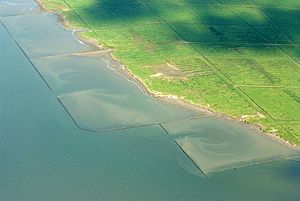Polder facts for kids

Empoldering is a special way to create new land from water. It helps control floods and makes more space for people. This process uses something called a polder. A polder is a piece of land that used to be underwater. It's made by building strong walls called dikes and digging canals to remove water.
Most empoldering happens in low areas near the coast. But it can also be done in places like lakes or rivers. The Netherlands is a great example of this. A lot of their country is actually below sea level. About one-fifth of the land in the Netherlands was once covered by water. Their biggest project was creating land from the Zuiderzee.
Polders have two main parts. First, they are surrounded by dikes. These dikes keep the water out. They also protect the land from being washed away by waves. Second, polders need constant care. They have systems of canals and pumps. These systems keep the land from getting too wet. This makes the land good for farming and building.
Contents
How We Make New Land: The Empoldering Process
Making a polder involves several important steps. Each step helps turn a watery area into useful land.
Step 1: Building a Strong Wall
First, a large dike is built around the area. This dike acts like a giant wall. Its job is to stop water from coming into the new land.
Step 2: Draining the Water Out
Next, the area inside the dike is drained. Big pumps and drainage canals are used. They work together to remove all the water. This makes the land dry.
Step 3: Planting Special Grasses
After the water is gone, special plants are sown. These are often "reeds". Reeds are a type of plant that can grow in salty soil. They are often dropped by aircraft. These plants help the soil become stronger and more stable.
Step 4: Preparing the Soil
After about three years, the reeds are burned. The ash from the burnt reeds is very useful. It acts like a natural fertilizer for the soil. This makes the land even better for growing things.
Step 5: Ready for Use
It takes a while for the land to be fully ready. After up to 15 years, the polder is complete. Now, it can be used for many things. People can grow crops, build houses, and create roads on this new land.
Challenges of Creating New Land
Creating new land from the sea is a big project. It comes with some challenges.
- High Costs: It costs a lot of money to reclaim land from deeper waters. The deeper the water, the more expensive it becomes.
- Finding Enough Sand: You need a lot of sand to build dikes and prepare the land. Sometimes, it's hard to find enough sand.
- Border Disputes: When new land is made, it can sometimes cause arguments. Countries might disagree about who owns the new land.
Images for kids
-
Aerial view of Flevopolder, the Netherlands
-
Satellite image of Noordoostpolder, the Netherlands (595.41 km2)
-
Pumping station in Zoetermeer, Netherlands: The polder lies lower than the surrounding water on the other side of the dyke. The Archimedes' screws are clearly visible.
-
The Yser river and West Flemish polders near Diksmuide
-
Wind farms in the Noordoostpolder
See also
 In Spanish: Pólder para niños
In Spanish: Pólder para niños











